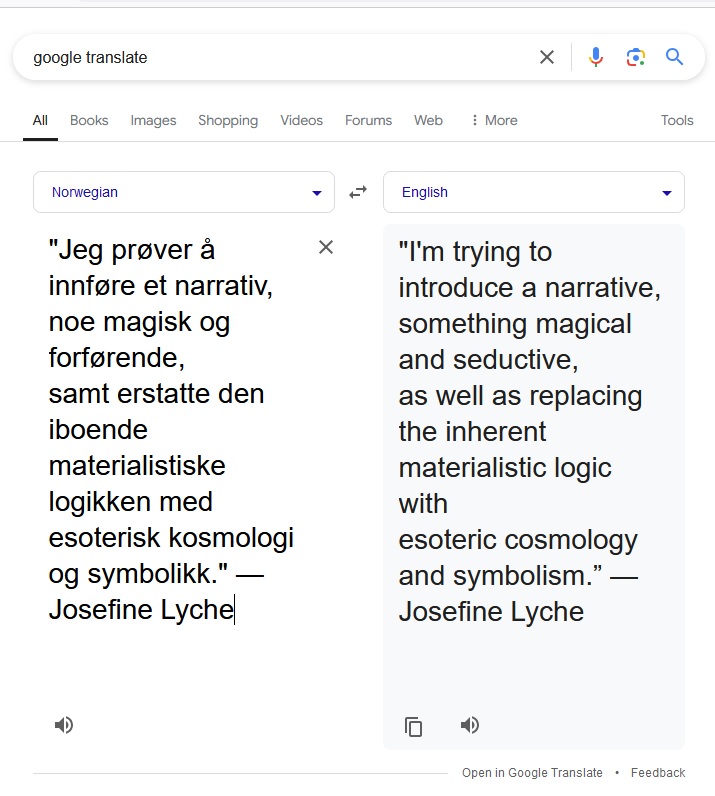Wednesday, September 11, 2024


And then there is another quiet flow . . .


A rumored work in progress from East Berlin . . .
Softly Flows the Conewago
by East Berlin author Nancy Springer
Also by Springer —

“They are the horses of a dream.
They are not what they seem.”
— The Hex Witch of Seldom, page 16
See as well a dies natalis — January 6, 2016 —
that shares an Epiphany with the Guardian's
"Nobel losers" article . . .

Comments Off on Quiet Flows
Passing the T-Square to a New Generation:


Comments Off on After Midnight . . .
Tuesday, September 10, 2024
Comments Off on Midnight for the Master’s Margaritas*
Today's previous post presented historic logos of
the ABC that is the Australian Broadcasting Corporation.
An exact quote from tonight's broadcast on an American
ABC network —
"I meet with people all the time who tell me,
can we please just have discourse about
how we're going to invest in the aspirations and
the ambitions and the dreams of the American people…."
— Blue Party candidate
Her debate opponent, the Red Party candidate,
might well have replied . . .
"I meet with people all the time who tell me,
I'm mad as hell and I'm not going to take it any more!"
Related art from this journal:
The September 5 post Make Hollywood Sane Again —


Comments Off on The ABC’s of Logos … Networks!

"Please wait as your operating system is initiated."

Comments Off on System
"… dum frater sororis suae automata per clostellum miratur …."

Related reading . . .
"At the end of a long road was a drive that led to a large house . . . ."
Comments Off on Annals of Fashion: The Maltese Keyhole
Comments Off on For a Field of Dreams
Comments Off on For a “Wonder Boy” (and the Akeley Swamp)
Monday, September 9, 2024
Mauldin . . .

Or Maudlin . . .

Comments Off on Your Choice
Comments Off on Accentuate the Positive
Orthodox:

Unorthodox:

Related mathematical vocabulary . . .

Comments Off on Romanian Services
The homepage banner story from today's online New Yorker —



See also Moynahan.
Comments Off on A Narrative: “Treating The New Yorker as a Laboratory”
Comments Off on For “The Perfect Couple” — Facets and Labyrinth
MARY POPPINS, JACK & ALL —
OH, A COVER IS NOT THE BOOK
SO OPEN IT UP AND TAKE A LOOK
CAUSE UNDER THE COVERS ONE DISCOVERS . . . .

Comments Off on The Campaign Song of Mary Poppins
Compare and contrast:
Rip Torn and Rose the Hat.
Comments Off on Smile
Comments Off on Walpurgisnacht 2021: Seams Dreams
Sunday, September 8, 2024

Now added to a Likewise.com list —
The Portage to San Cristobal of A. H.
Related reading —
On a letter from Hebrew, the fentanyl of languages —
Coxeter's Aleph.
Comments Off on Language Game: Sunday in the Park with Steiner
Today's host for a special political edition of CBS Sunday Morning
is Ted Koppel. Vocabulary review:

Koppel's appearance today was backed by the usual CBS Sunday Morning
sun-disk Apollo symbol. An Apollo symbol that some may prefer —
The Ninefold Square
|
Rosalind Krauss
in "Grids," 1979:
"If we open any tract– Plastic Art and Pure Plastic Art or The Non-Objective World , for instance– we will find that Mondrian and Malevich are not discussing canvas or pigment or graphite or any other form of matter. They are talking about Being or Mind or Spirit. From their point of view, the grid is a staircase to the Universal, and they are not interested in what happens below in the Concrete.
Or, to take a more up-to-date example…."
"He was looking at the nine engravings and at the circle,
checking strange correspondences between them."
– The Club Dumas , 1993
"And it's whispered that soon if we all call the tune
Then the piper will lead us to reason."
– Robert Plant, 1971
The nine engravings of The Club Dumas
(filmed as "The Ninth Gate") are perhaps more
an example of the concrete than of the universal.
An example of the universal— or, according to Krauss,
a "staircase" to the universal— is the ninefold square:

"This is the garden of Apollo, the field of Reason…."
– John Outram, architect
|
Comments Off on Sunday Morning Koppel
… in posts tagged Kummer-Sept-2013.
Musical accompaniment suggested by
tonight's earlier Paradise Dreams —

Comments Off on Mathematics and Narrative: T. S. Eliot Meets Stephen King
I have my own dreams of paradise, but will settle for companionship that is
merely purgatorial.
Comments Off on Annals of Journalism: In Search of Deep Throat

|
Jessica H: My parents' usual ritual was that shortly before Dad's expected arrival at home, Mom would freshen up in preparation. She put on a little lipstick, take off her apron sometimes, and maybe change her blouse, splash on some perfume, and when Dad was home and settled in his favorite chair in the living room, they'd pour drinks and discuss the events of the day, his day.
Some months ago my mother gave me an article that she'd found from the 1950's that offered tips to women on the proper way to welcome your man at home after a hard day's work. She read me those guidelines and her comments on them revealed that she had fooled us all. While back in the day she had seemed to be that era's model of a perfect housewife, she was actually downright subversive.
Eleanor H: "Prepare yourself, take 15 minutes to rest so you will be refreshed when he arrives." Meanwhile, the kids are throwing their blocks out the window.
Jessica H: (laughs)
Eleanor H: "Touch up your makeup, put a ribbon in your hair." If I put a ribbon in my hair my husband would leave home. "Be fresh looking, be a little gay and a little more interesting." If he's so bored he should change jobs. "He Probably needs a lift."
Eleanor H: "Prepare the children." Make sure you have just one. (laughs)
Jessica H: (laughs)
Eleanor H: "Take a few minutes to wash their hands and faces. They are little treasures, and he would like to see them like that." Well, wouldn't we all. (laughs)
Jessica H: (laughs)
Eleanor H: "Be happy to see him, greet him with a smile, and be glad to see him." One more mouth to feed. "Have dinner (laughs) have dinner ready." He doesn't care a thing about dinner, he wants his drink. "Most men are hungry when they come home." Here you are meat loaf, mashed potatoes. Stuff it down 'cause I worked hard on it.
Jessica H: (laughs)
Eleanor H: "Have him lean back into a comfortable chair, or suggest that he lie down in the bedroom." How about suggesting that we both lie down in the bedroom?
Jessica H: (laughs)
Eleanor H: "Make the evening his. Never complain if he doesn't take you out to dinner or to other places of entertainment." You could just rot instead. (laughs) "Try to understand his world of strain and pressure." What about my world of strain and pressure? "Try to make your home a place of peace and order, where your husband can renew himself in body and spirit," while you go down the tubes.
Jessica H: (laughs)
As mom said, she understood that what Dad really required was a drink. He needed to be defused, and we kids steered clear of that living room until that essential transition from sober to tipsy had taken place. Sometimes when my brother Charlie was a little older, nine or ten, he'd venture into their space, but only very cautiously.
— http://www.winnetkapodcast.com/episode-6-transcript

|
Comments Off on More Source Material for Stephen King
Exploring Color Space :
"The texts Brown received about Gray . . . ."
Alternate Title:
"Doctor Sleep's Jug Tavern Group Notes"

Comments Off on A Washington Post Exclusive
"The stars are bright, they shine at night . . . ."
— Adapted song lyric

"Kercheval, Kesey . . . . Kesey, Kercheval."
Comments Off on Doing Dallas
Saturday, September 7, 2024
Comments Off on Jazz Links
See the post "The Ghent Links" from the day a former Vanity Fair
art director turned 81.
Peacock fans may prefer a back-door view from Las Mañanitas .
Comments Off on Whiteout
Comments Off on The Ballad* of Physical Frameworks

Bloomsday, and then Galois's birthday, and then . . . Square Space!
"Ride a painted pony, let the spinning wheel spin."
Comments Off on Annals of Cultural History
Comments Off on Summer Love: “Eat your heart out, Sandy Olsson.”
Friday, September 6, 2024
A Rolling Stone obituary today for Sérgio Mendes suggests . . .

Related material from this journal . . .
|
Umberto Eco,
Foucault’s Pendulum,
page 176:
Here, too, you entered through a little garden…
Amparo drew me aside as we went in. “I’ve figured it out,” she said. “That tapir at the lecture talked about the Aryan age, remember? And this one talks about the decline of the West. Blut und Boden, blood and earth. It’s pure Nazism.”
“It’s not that simple, darling. This is a different continent.”….
If the outside was seedy, the inside was a blaze of violent colors. It was a quadrangular hall, with one area set aside for the dancing of the cavalos. The altar was at the far end, protected by a railing, against which stood the platform for the drums, the atabaques. The ritual space was still empty….
|
Comments Off on Rolling Stone Obituary Note
A search in this journal for "Verbo" yields a song lyric . . .
"First we'll show and tell
'Til I reach your pony tail"
— Song lyric
See also related choreography for a "Danny Zuko" in my hometown.
Comments Off on Suggestive Search
Excerpt from a post, now private, on Augustine's Day 2024 . . .

|
"Every city has its gates, which need not be of stone. Nor need soldiers be upon them or watchers before them. At first, when cities were jewels in a dark and mysterious world, they tended to be round and they had protective walls. To enter, one had to pass through gates, the reward for which was shelter from the overwhelming forests and seas, the merciless and taxing expanse of greens, whites, and blues–wild and free–that stopped at the city walls.
In time the ramparts became higher and the gates more massive, until they simply disappeared and were replaced by barriers, subtler than stone, that girded every city like a crown and held in its spirit."
— Mark Helprin, Winter's Tale
|
A rather different religious quote from this journal three days later —
"kalosmi lokaksaya krt pravrddho"
Comments Off on Tikkun for Augustine
Comments Off on Hometown Blues
Introduction . . .


See also Figaro by Cartier .

Update of 10:38 AM ET . . . A check on the author of the above yields:

Update of 10:46 AM ET . . .

Comments Off on Note by an Intimation Coordinator

See also other posts now tagged Dream Song.
Comments Off on Michigan Roll
(With apologies to Kipling.)

And as den mother for this Romulus and Remus . . .


"Se necesita una poca de gracia." — Song lyric.
Comments Off on Sketch for a Blackboard Jungle Book
Comments Off on The Cinematic Imagination: Burning Rider Revisited
Thursday, September 5, 2024
The publisher name "Holden-Day" in the previous post suggests . . .


Comments Off on Make Hollywood Sane Again

I prefer K .


"Before time began . . . ." — Optimus Prime
Comments Off on Cereal Tales

Related material —

Comments Off on Waiting for Quine: Stool School

See as well Nabokov and Gibson on synesthesia.

"A curriculum, a vigor, a local abstraction . . . " — Wallace Stevens
Comments Off on Folie à Trois: Spanish Steps in Times Square
Comments Off on Rydell High Song: “Nel Blu di Pinto di Blu”… Adapted.
Comments Off on “No Ordinary Venue”
Wednesday, September 4, 2024

— "Lede Master, how do I get to Carnegie Hall?"
— "Pearl, you must fuck the scarecrow well ."
Comments Off on Mystic Straw Dogs Dialogue
Comments Off on Wire Service: The Lede Master
Comments Off on Scream with your T?
Comments Off on If You Prefer Fall Vibes with a Scream …

From a post, now private, in this journal on June 17, 2024 —
James Hillman
EGALITARIAN TYPOLOGIES
VERSUS THE PERCEPTION OF THE UNIQUE
“The kind of movement Olson urges is an inward deepening of the image,
an in-sighting of the superimposed levels of significance within it.
This is the very mode that Jung suggested for grasping dreams —
not as a sequence in time, but as revolving around a nodal complex.”
See as well "True Grids" (Log24, August 9, 2018).
Comments Off on Autumn Ninefold Square
Tuesday, September 3, 2024

From a search in this journal . . .

Also related, but only very personally and indirectly, to Iceland . . .

“At the still point . . . .” — T. S. Eliot
Comments Off on Windows Mini-Doodle
"… to explore what it means to be human
in all the facets of that and the labyrinth of that."
— Nicole Kidman at the 2024 Venice Film Festival.
See as well Facets and Labyrinth in this journal.
Comments Off on Mission: Possible — Facets and Labyrinth

The Coconut Dance —

The above YouTube upload date: April 17, 2020.
"It was — and is — very difficult to focus, to navigate
between each sentence and its real-time double,
to find the fuzzy edges where these reflections meet."
— This journal on April 17, 2020, in a passage quoted
from a Laura Marris essay in The New York Times.
Comments Off on “Real-Time Strategy Games”
Monday, September 2, 2024
Comments Off on “The Grand Old Duke of York” *
Comments Off on Another Opening, Another Show
Comments Off on Zen and the Tool
Comments Off on Art for a Blue Parrot Café
Sunday, September 1, 2024
The Cinematic Imagination:
“Frida” Meets “Under the Volcano”

A scene from “Frida” and a scene from the Day of the Dead
festival, Cuernavaca, 30 October 2004.
For Diego Rivera (and Francis Ford Coppola) . . .
"Beyond his mathematics was the unknown. Were his final writings,
an avalanche of 70,000 pages in an often near-illegible hand,
the aimless scribblings of a madman? Or had the anchorite of Lasserre
made one last thrust into the secret architecture of the universe?"
— Phil Hoad in The Guardian , "Sat 31 Aug 2024 06.00 EDT"
Some impressive Chrysler Building thrusts . . .


Related cinematic entertainment . . .

Comments Off on Annals of Secret Architecture: The Chrysler Thrusts

Comment —

Comments Off on The Light at the Top of the Stairs
From the previous post's search for Bester . . .
Strip joints I prefer . . .


Comments Off on Strip Joints
Sunday Best: The link Sunday Art from the previous post.
Sunday Bester: The author Alfred Bester in this journal.
Comments Off on Sunday Best Meets Sunday Bester
Saturday, August 31, 2024


The date of the the above photo, November 8, 2015, suggests a look
at this journal on that date. See Sunday Art.
Comments Off on Annals of British Humor
"kalosmi lokaksaya krt pravrddho"

Also on July 13, 2023 . . .
From the Publications webpage of Dan Gordon —
Math Databases on the Cheap,
lightning talk at LuCaNT, July 2023.
Background from 2022 —
Gordon's informative webpage on mathematical repositories:
https://ljcr.dmgordon.org/cwm/jupyter_book/math_repos.html.
Not so cheap —

See also ICERM in this journal on November 14, 2012.
Comments Off on Script Idea for Harlan Kane:
The Timeless Meets Time
Friday, August 30, 2024
Comments Off on Annals of Geometric Group Theory
From August 17 —
-Representations-Wikipedia.jpg)
Also from August 17, a dies natalis —

I prefer the "three D's" of Debbie Does Dallas.
Comments Off on Dimensions
Thursday, August 29, 2024
Peter Woit this afternoon on "The Terrifying Power of Mathematics" —
"… the quantum field theory of fields satisfying the Dirac equation.
Here there’s a standard apparatus of how to calculate given in
every quantum field theory textbook. These standard calculations
involving Dirac gamma-matrices fit well with Feynman’s 'physicists
finding they have the correct equations without understanding them
have been so terrified they give up trying to understand them'."
For a definition of these matrices, see . . .
Weisstein, Eric W. "Dirac Matrices."
From MathWorld — A Wolfram Web Resource.
https://mathworld.wolfram.com/DiracMatrices.html —
"The Dirac matrices are a class of 4×4 matrices which arise
in quantum electrodynamics. There are a variety of different
symbols used, and Dirac matrices are also known as
gamma matrices or Dirac gamma matrices."
For related religious remarks, see "Physics for Poets"
( Log24, April 20, 2022 ).
Comments Off on Fearful Symmetry

In related news . . .

Comments Off on Walpurgisnacht and More!
Today’s Zuckerberg Temptation
Tag suggested by the previous post and by the dies natalis
in a New York Times obituary from today —
Kesey Benchmarks . . .

Comments Off on The Coal Mining Daughters
Scene from a TV series that reportedly reached Anya Taylor-Joy's
childhood home, Argentina, on August 29, 2021 . . .

Clip of Taylor-Joy in a film that opened on Augustine's Day, 2020.

Taylor-Joy is currently streaming in "Furiosa."
"She comes from a place of abundance."
Comments Off on Amaya
Wednesday, August 28, 2024
'In the wide realm of the world
there are ancient forms,
incorruptible and eternal forms —
any one of them might be
the symbol that I sought."
— "The Writing of the God," by Jorge Luis Borges
"The governor showed him a cell
whose floor, walls, and vaulted ceiling
were covered by a drawing (in barbaric colors
that time, before obliterating, had refined)
of an infinite tiger. It was a tiger composed of
many tigers, in the most dizzying of ways;
it was crisscrossed with tigers, striped with tigers,
and contained seas and Himalayas and armies
that resembled other tigers."
— "The Zahir," by Jorge Luis Borges
Related art:
https://www.instagram.com/miapensa/.
Comments Off on Forms

See also June 16, 2008, in this journal.
Comments Off on Games Theory
Tuesday, August 27, 2024
From this journal on November 21, 2011 . . .
Joseph T. Clark, S. J., Conventional Logic and Modern Logic:
A Prelude to Transition (Philosophical Studies of the American
Catholic Philosophical Association, III) Woodstock, Maryland:
Woodstock College Press, 1952—
|
Alonzo Church, "Logic: formal, symbolic, traditional," Dictionary of Philosophy (New York: Philosophical Library, 1942), pp. 170-182.
|
The contents of this ambitious Dictionary are most uneven. Random reference to its pages is dangerous. But this contribution is among its best. It is condensed. But not dense. A patient and attentive study will pay big dividends in comprehension. Church knows the field and knows how to depict it. A most valuable reference.
|

Comments Off on Design Logic

The above is six-dimensional as an affine space, but only five-dimensional
as a projective space . . . the space PG(5, 2).
As the domain of the smallest model of the Klein correspondence and the
Klein quadric, PG (5,2) is not without mathematical importance.
See Chess Bricks and Ovid.group.
This post was suggested by the date July 6, 2024 in a Warren, PA obituary
and by that date in this journal.
Comments Off on For Rubik Worshippers
"It's going to be accomplished in steps,
this establishment of the Talented
in the scheme of things."
— To Ride Pegasus ,
by Anne McCaffrey* (Radcliffe '47)
An AI image created on Feb. 24, 2024, by https://neural.love —
"Lily Collins Playing Chess" —



* Dies Natalis: November 21, 2011.
Comments Off on “Accomplished in Steps”
Monday, August 26, 2024

A scholium for International Dog Day:
Amores Perros.
Comments Off on For the Spanish Steps: Amores Perros
Comments Off on Annals of Entertainment:
Emily in Paris Meets Eyes Wide Shut
Comments Off on The Groping . . .
Sunday, August 25, 2024
Comments Off on Dramarama for Ace Ventura
From the post "Log Lady" of June 12, 2020 —
"Battle of White has raged on endlessly.
Everywhere Black will strive to seal his fate."
— Katherine Neville's chess novel The Eight
For Nathalie Emmanuel, star of the recent Francis Ford Coppola
extravaganza "Megalopolis" and, more impressively, of
a John Woo film released to streaming on Aug. 23 . . .

Comments Off on Log Lady Lines
Saturday, August 24, 2024


See as well the previous post for the above "Pearl" filming location,
an alley beside a movie theater in Whanganui, New Zealand.

Comments Off on Right Up Sturgeon’s Alley
For Theodore Sturgeon (in Vonnegut's oeuvre, "Kilgore Trout") —
Memoir of a (fictional) Whanganui Projectionist and . . .

Related posts: Music for Steiner .
Comments Off on Bunker Bingo …
From a Log24 post of May 11, 2022 . . .

From a John Woo film released to streaming on Aug. 23 . . .

Related reading: Hexagram 43.
Comments Off on Landmarks


See as well Pale Fire in this journal and . . .

Comments Off on Language Game for Harlan Kane:
The Mountain Fountain
Comments Off on Into the Woods
Foreword: Emmanuel in this journal.


Prompted by the time 0:47:41 in the above John Woo scene,
some may wish to consult hexagrams 47 and 41.
Comments Off on From Megalopolis … Back to Paris
Friday, August 23, 2024


For James Joyce . . . "Here Comes Little Miss Everybody!"

Comments Off on One Hundred Years of Showbiz
Comments Off on The Four-Year Scratch
In my long-ago high school days, the above title referred to
an imaginary local institution of higher education.
Memories of those days inspired the URL Scandia.tech.
See also the real Scandia, about nine miles northeast of my old school . . .

Comments Off on Scandia Tech

From the Feast of Saint Nicholas, 2023 . . .

Comments Off on For Harlan Kane: The Sicilian Defense
Thursday, August 22, 2024

A more sophisticated alpha and omega . . .

— R. T. Curtis, "A New Combinatorial Approach to M 24 ,"
Mathematical Proceedings of the Cambridge Philosophical Society (1976), 79: 25-42
A related key . . .
"It must be remarked that these 8 heptads are the key to an elegant proof…."
— Philippe Cara, "RWPRI Geometries for the Alternating Group A8," in
Finite Geometries: Proceedings of the Fourth Isle of Thorns Conference
(July 16-21, 2000), Kluwer Academic Publishers, 2001, ed. Aart Blokhuis,
James W. P. Hirschfeld, Dieter Jungnickel, and Joseph A. Thas, pp. 61-97.
Comments Off on Locke & Key: Alpha & Omega

Another "immersive fan-driven adventure" —
"Where were you when the shit hit the fan?"

Comments Off on Today’s Zuckerberg Temptation

"Ostlund says that […] 'a lot of the topics in the film
are inspired by Marxist theories.' "
A rather differently inspired square-then-triangle saga . . .
Figurate Geometry.
Comments Off on Geometric Followups
Wednesday, August 21, 2024

Related reading . . . Other posts now tagged "Original Conspiracy."
Comments Off on “Triangle of Sadness” Conspiracy?
Comments Off on For a Fictional “Magic Child” *
From other posts now tagged Dark Symbol —

The apparent symbols for "times" and "plus"
in the above screenshot are, of course, icons for
browser functions. Readers who prefer the
fanciful may regard them instead as symbols for
"a gateway to another realm," that of number theory.
* See Hemingway on pilot fish and an Instagram post
from Boxing Day, 2016.
Comments Off on Annals of Symbology:
For a New York Times Pilot Fish*


For tributes from friends of Cross, see today's Seattle Times.
Comments Off on Seattle Redefinition
Tuesday, August 20, 2024
|
Peter Woit today
(https://www.math.columbia.edu/~woit/wordpress/?p=14092):
From the beginning in 1984 I was dubious about string theory unification, and by the late 1990s could not understand why this was dominating physics departments and popular science outlets, with no acknowledgement of the serious problems and failures of the theory. From talking privately to physicists, it became clear that the field of particle theory had for quite a while become disturbingly tribal. There was a string theory tribe, seeing itself as embattled and fighting less intelligent other tribes for scarce resources. Those within the tribe wouldn’t say anything publicly critical of the theory, since that would not only hurt their own interests, but possibly get them kicked out of the tribe. Those outside the tribe also were very leery of saying anything, partly because they felt they lacked the expertise to do so, partly because they feared retribution from powerful figures in the string theory tribe.
|
See also http://m759.net/wordpress/?tag=tri-be.
Comments Off on Academic Tribes
From a DNC speech this evening . . .
"When the political will is there, government CAN effectively deliver
for the people of our country. We need to summon that will again…."
Related inspirational material —

Comments Off on The Political Will
On Friday, May 10, 2024, The Guardian reported the May 9 death
of rock drummer "Machine Gun" Thompson.
See as well a countdown requiem — May 10 News in this journal.
"The countdown as we know it, 10-9-8-u.s.w.,
was invented by Fritz Lang in 1929 for
the Ufa film Die Frau im Mond . He put it into
the launch scene to heighten the suspense.
'It is another of my damned "touches,"' Fritz Lang said."
— Gravity's Rainbow
Comments Off on A Different Drummer
Comments Off on “But this torch that I found . . .” — Sinatra
Comments Off on Biden by Torchlight

From the above piece by Colby College professor Scott Taylor —
"… a metaphorical 'Rosetta stone' of analogies between
advanced versions of three basic mathematical objects:
numbers, polynomials and geometric spaces."
This is the same sort of contemptible dumbing-down discussed here in
a May 8, 2024 post. In fact, it links to the Quanta essay discussed in that post.
A rather different connection between the above "three basic
mathematical objects" —

Comments Off on Bullshit Studies
Monday, August 19, 2024
Comments Off on Space Odyssey 2024: Parlons.
Continued from Saturday, August 17.
A search for "Cullinane square model" —

Comments Off on Space Odyssey 2001-2024 . . .
Sunday, August 18, 2024
Comments Off on Flashback
Comments Off on Rewind Tour
Comments Off on Road to Chicago

|
“The yarns of seamen have a direct simplicity,
the whole meaning of which lies within the shell
of a cracked nut. But Marlow was not typical
(if his propensity to spin yarns be excepted),
and to him the meaning of an episode was
not inside like a kernel but outside,
enveloping the tale which brought it out only
as a glow brings out a haze, in the likeness of
one of these misty halos that sometimes
are made visible by the spectral illumination of
moonshine.”
— Joseph Conrad in Heart of Darkness
“By groping toward the light we are made to realize
how deep the darkness is around us.”
— Arthur Koestler, The Call Girls: A Tragi-Comedy,
Random House, 1973, page 118
|
From an obituary of Alain Delon, who reportedly died today . . .
|
"He starred in the 1976 French best picture winner, 'Mr. Klein,' as a wartime German art dealer threatened by being mistaken for a Jewish man with the same name."
— Anita Gates in The New York Times
|
See as well Felix Christian Klein in this journal.
And then there is being mistaken for a fictional archaeologist
with the same name.
Comments Off on “Like a Kernel”
|
A brief excerpt from a 2018 book about the woman who inspired Zen and the Art of Motorcycle Maintenance . . .
"There is a passage in Joseph Conrad’s novella, Heart of Darkness (1899), which exemplifies much about what Quality means . . . .
… the narrator, Marlow … is … in an environment he finds malign, sinister, macabre, chaotic, indifferently cruel, and nightmarishly meaningless. What saves him is his accidental discovery of a dry old seamanship manual . . . ."
Conrad, as quoted in the book cited below:
It was an extraordinary find. Its title was An Inquiry into some Points of Seamanship, by a man Towser, Towson – some such name – Master in his Majesty’s Navy. The matter looked dreary reading enough, with illustrative diagrams and repulsive tables of figures, and the copy was sixty years old. I handled this amazing antiquity with the greatest possible tenderness, lest it should dissolve in my hands. Within, Towson or Towser was inquiring earnestly into the breaking strain of ships’ chains and tackle, and other such matters. Not a very enthralling book; but at the first glance you could see there a singleness of intention, an honest concern for the right way of going to work, which made these humble pages, thought out so many years ago, luminous with another than a professional light. The simple old sailor, with his talk of chains and purchases, made me forget the jungle and the pilgrims in a delicious sensation of having come upon something unmistakably real.
— From pp. 36-37 of James Essinger and Henry Gurr's
A Woman of Quality:
Sarah Vinke, ‘The Divine Sarah’, and the Quest for the Origin of Robert Pirsig's 'Metaphysics of Quality' in his Book Zen and the Art of Motorcycle Maintenance .
|
See also earlier posts tagged Weir'd.
Comments Off on Heart of Weir’d . . . For Mr. Kurtz
Saturday, August 17, 2024
"I need a photo opportunity . . . ." — Paul Simon

Comments Off on Weir’d II —
For “the stuffed men,” “the hollow men” —
A “Project Hail Mary” from the Feast of the Assumption

The producer in question will reportedly "reunite with
Christopher Miller and Phil Lord — the co-writers of 'Spider-Man:
Across the Spider-Verse' (2023) — on an adaptation of
Andy Weir’s 2021 sci-fi novel, 'Project Hail Mary.' " [Link added.]
Some might prefer to be Weir'd in a more traditional way . . .

Comments Off on Weir’d!


-Representations-Wikipedia.jpg)
As for what Polster called "God's fingerprint" . . .
Desargues via Galois.
A version for Hollywood —

Comments Off on Space Odyssey . . . 2001 to 2024
Friday, August 16, 2024
Comments Off on Brightness at Noon
Variety reports an August 15 death —


A related flashback posted here yesterday afternoon —

Comments Off on The Departure Bus
Thursday, August 15, 2024
As G. M. Conwell pointed out in a 1910 paper, the group of all
40,320 permutations of an 8-element set is the same, in an
abstract sense, as the group of all collineations and dualities
of PG(3,2), the projective 3-space over the 2-element field.
This suggests we study the geometry related to the above group's
actions on the 105 partitions of an 8-set into four separate 2-sets.
Note that 105 equals 15×7 and also 35×3.
In such a study, the 15 points of PG(3,2) might correspond (somehow)
to 15 pairwise-disjoint seven-element subsets of the set of 105 partitions,
and the 35 lines of PG(3,2) might correspond (somehow) to 35 pairwise-
disjoint three-element subsets of the set of 105 partitions.
Exercise: Is this a mere pipe dream?
A search for such a study yields some useful background . . .
 .
.
Taylor's Index of Names includes neither Conwell nor the
more recent, highly relevant, names Curtis and Conway .



Comments Off on Geometry Exercise
Comments Off on Compare and Contrast

Related reading —

Comments Off on Iconology
A search in this journal for "Wallace Stevens died" is
suggested by a New York Times obituary this afternoon . . .

Comments Off on Dies Natalis
Comedian's version —

Mathematician's version
(from a Log24 search for Set Design) —

Comments Off on For Carson: Set Design School
« Newer Posts —
Older Posts »






























































































-Representations-Wikipedia.jpg)









































































 .
.






